
Monetary Economics - Lopes & Rossetti
Monetary Economics: A Comprehensive Guide to the World of Money and Banking
Introduction
In today's complex and ever-changing financial landscape, understanding monetary economics is crucial for navigating the intricacies of money and banking. Monetary Economics, authored by the renowned economists Francisco Lopes and Paulo Rossetti, provides a comprehensive and accessible guide to this fascinating field. With its in-depth analysis, real-world examples, and engaging writing style, this book is a must-read for anyone seeking to gain a deeper understanding of the monetary system and its impact on the global economy.
Exploring the Foundations of Monetary Economics
Lopes and Rossetti begin by laying a solid foundation in monetary theory, introducing readers to the fundamental concepts and principles that govern the creation and management of money. They delve into the nature of money, its functions, and the various forms it can take, from physical currency to electronic money. The book also explores the role of central banks in regulating the money supply and maintaining financial stability, highlighting the delicate balance between stimulating economic growth and controlling inflation.
Understanding Monetary Policy and its Instruments
At the heart of monetary economics lies monetary policy, the strategies employed by central banks to influence the money supply and interest rates. Lopes and Rossetti provide a comprehensive overview of the different monetary policy instruments, including reserve requirements, open market operations, and the discount rate. They explain how central banks use these tools to achieve their monetary policy objectives, such as controlling inflation, promoting economic growth, and stabilizing financial markets.
Analyzing the Interplay of Money and the Economy
The book delves into the intricate relationship between money and the economy, examining how changes in the money supply affect economic variables such as output, employment, and prices. Lopes and Rossetti explore the concept of the quantity theory of money, which posits a direct relationship between the money supply and the price level. They also discuss the role of money in economic growth, highlighting the importance of financial intermediation and the efficient allocation of resources.
Exploring International Monetary Issues
In an increasingly interconnected global economy, understanding international monetary issues is essential. Lopes and Rossetti dedicate a significant portion of the book to analyzing exchange rates, balance of payments, and the international monetary system. They examine the factors that determine exchange rates, the challenges of managing floating exchange rate regimes, and the role of international organizations like the International Monetary Fund (IMF) in promoting global monetary cooperation.
Real-World Applications and Case Studies
To solidify readers' understanding of monetary economics, the book presents a wealth of real-world applications and case studies. These examples illustrate how monetary policy decisions impact economies around the world, from the United States to Europe and emerging markets. By examining historical events and contemporary challenges, Lopes and Rossetti bring the concepts to life and demonstrate the practical relevance of monetary economics.
Conclusion
Monetary Economics by Francisco Lopes and Paulo Rossetti is an indispensable resource for anyone seeking to master the complexities of money and banking. With its comprehensive coverage, clear explanations, and engaging writing style, this book is an invaluable guide for students, professionals, and anyone interested in gaining a deeper understanding of the monetary system and its impact on the global economy. Embrace the world of monetary economics and unlock the key to making informed financial decisions and navigating the ever-changing financial landscape with confidence.